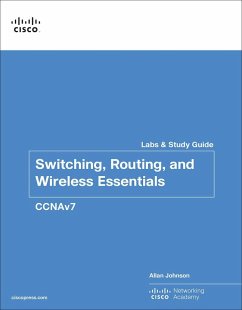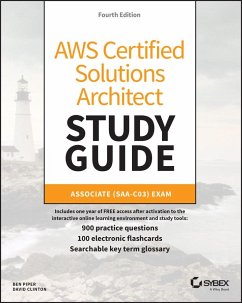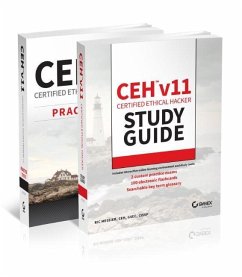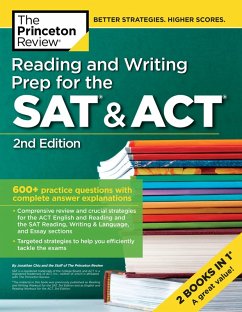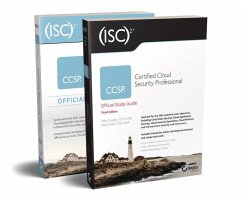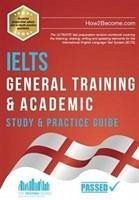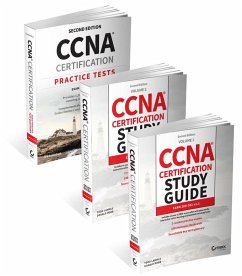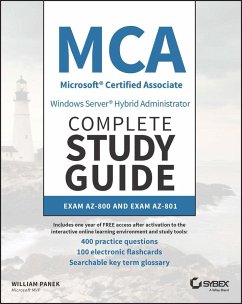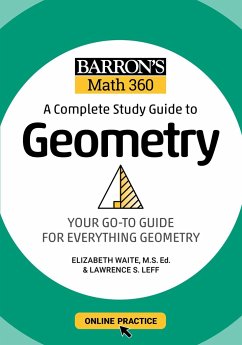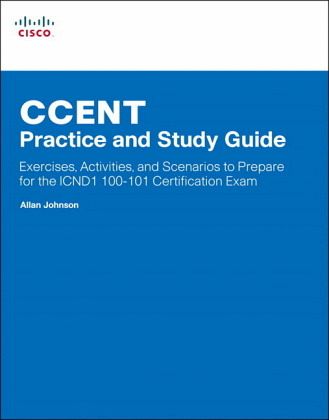
CCENT Practice and Study Guide
Exercises, Activities and Scenarios to Prepare for the ICND1 100-101 Certification Exam
Versandkostenfrei!
Versandfertig in 2-4 Wochen
24,99 €
inkl. MwSt.

PAYBACK Punkte
12 °P sammeln!
More practice leads directly to better scores -- especially when it comes to Cisco's revamped CCENT/ICND1 Certification Exam. Straight from Cisco and the Cisco Networking Academy, CCENT Practice and Study Guide delivers all the practice you’ll need. This practice handbook is the ideal supplement for all four courses in CNA’s new CCNA Routing & Switching Curriculum, including Introduction to Networking, Network Basics, Routing Protocols, and Routing & Switching Essentials. Its exercises, activities, and scenarios are designed to support all kinds of learners and learning styles, and either classroom instruction or self-study. You’ll find:
Vocabulary matching and/or completion exercises
Identifying/labeling/selecting/ordering exercises
Calculations
Concept questions
Design scenarios
Opportunities to document configuration and verification steps
Troubleshooting scenarios, and more
CCENT Practice and Study Guide contains three types of labs: Basic, Challenge, and Troubleshooting. Each lab type has been designed so you can solve it using pen and paper, on actual Cisco equipment, or with a simulator such as GNS, Boson, or Packet Tracer.
Throughout, all topics are mapped to complementary Cisco and CNA study resources, helping you study more efficiently, whether you’re in a classroom or on your own.
Product Description
CCENT Practice and Study Guide is designed with dozens of exercises to help you learn the concepts and configurations crucial to your success with the Interconnecting Cisco Networking Devices Part 1 (ICND1 100-101) exam.
The author has mapped the chapters of this book to the first two Cisco Networking Academy courses in the CCNA Routing and Switching curricula, Introduction to Networks and Routing and Switching Essentials. These courses cover the objectives of the Cisco Certified Networking Entry Technician (CCENT) certification. Getting your CCENT certification means that you have the knowledge and skills required to successfully install, operate, and troubleshoot a small branch office network.
As a Cisco Networking Academy student or someone taking CCENT-related classes from professional training organizations, or college- and university-level networking courses, you will gain a detailed understanding of routing by successfully completing all the exercises in this book.
Each chapter is designed with a variety of exercises, activities, and scenarios to help you:
· Review vocabulary
· Strengthen troubleshooting skills
· Boost configuration skills
· Reinforce concepts
· Research and analyze topics
Features + Benefits
Packed with study aids to support all forms of learning
Includes Basic, Challenge, and Troubleshooting labs that can be done with pen and paper, simulators, or actual equipment
Perfect for students enrolled in Cisco Networking Academy program and other CCNA training, and for self-study
Supplements the first two courses in the Cisco Networking Academy new CCNA Routing and Switching Curriculum
Part I: Introduction to Networks
CHAPTER 1 Exploring the Network 1
Globally Connected 1
Vocabulary Exercise: Matching 2
Completion Exercise 3
LANs, WANs, and the Internet 3
Completion Exercise 3
Classify and Identify Network Components 5
Compare LANs and WANs 6
Vocabulary Exercise: Matching 7
The Network as a Platform 8
Classify Network Architecture Requirements 8
The Changing Network Environment 10
Completion Exercise 10
Network Security Terminology 11
CHAPTER 2 Configuring a Network Operating System 13
IOS Bootcamp 13
Completion Exercise 13
Accessing a Cisco IOS Device 14
Navigating the IOS Matching Exercise 15
Basic Device Configuration 16
Applying a Basic Configuration 16
CHAPTER 3 Network Protocols and Communications 19
Rules of Communication 19
Vocabulary Exercise: Matching 20
Network Protocols and Standards 21
Protocol Definitions: Matching 21
Mapping the Protocols of the TCP/IP Suite 22
Explore the Purpose of Standards Organizations 22
OSI Reference Model Layers: Matching 24
TCP/IP Model Layers: Matching 24
Mapping the Layers of the OSI and TCP/IP Models 25
Moving Data in the Network 26
Data Encapsulation and the PDUs 26
The Role of Addressing in Network Communications 27
CHAPTER 4 Network Access 29
Physical Layer Protocols 29
Completion Exercise 29
Vocabulary Exercise: Matching 31
Network Media 32
Copper Cabling Completion Exercise 32
Compare UTP, STP, and Coaxial Characteristics 32
UTP Cabling Completion Exercise 33
UTP Cable Pinouts 34
Fiber-Optic Cabling Completion Exercise 34
Compare Single-Mode and Multimode Fiber 35
Wireless Media Completion Exercise 36
Data Link Layer Protocols 37
The Sublayers of the Data Link Layer 37
Label the Generic Frame Fields 37
Identify the Data Link Layer Standards Organization 37
Media Access Control 38
Topologies and Access Methods Completion Exercise 38
Label the Ethernet Frame Fields 39
Label the PPP Frame Fields 40
Label the 802.11 Wireless Frame Fields 40
CHAPTER 5 Ethernet 41
Ethernet Protocol 41
Ethernet Operation Completion Exercise 41
Identify the Ethernet Frame Attributes: Matching 42
Comparing Decimal, Binary, and Hexadecimal Digits 43
Address Resolution Protocol 43
Completion Exercise 43
Identify the MAC and IP Addresses 44
LAN Switches 45
Building the MAC Address Table 45
Switching Concepts Completion Exercise 46
Comparing Switch Forwarding Methods 47
Forward the Frame 47
Layer 3 Switching Concepts Completion Exercise 50
Layer 3 Switch Configuration 51
CHAPTER 6 Network Layer 53
Network Layer Protocols 53
The Processes of the Network Layer 53
Characteristics of the IP Protocol 53
Fields of the IPv4 Packet: Matching 55
Fields of the IPv6 Packet: Matching 55
Routing 56
How a Host Routes Packets Completion Exercise 56
Routing Table Entry: Matching 58
Routers 58
Identify Router Components 58
Router Boot Process Exercise 59
Interpreting the show version Command Exercise 60
Configuring a Cisco Router 60
Basic Router Configuration Exercise 60
Applying a Basic Configuration 62
Verifying Basic Router Configuration 63
CHAPTER 7 Transport Layer 65
Transport Layer Protocols 65
Transportation of Data Completion Exercise 65
Introducing TCP and UDP 66
TCP and UDP 66
TCP Communication 67
UDP Communication 69
TCP or UDP, That Is the Question 69
CHAPTER 8 IP Addressing 71
IPv4 Network Addresses 71
IPv4 Address Structure 71
IPv4 Subnet Mask 72
The Last Nonzero Octet 73
ANDing to Determine the Network Address 73
IPv4 Unicast, Broadcast, and Multicast 74
Types of IPv4 Addresses 74
IPv6 Network Addresses 75
Representing IPv6 Addresses 76
Identify IPv6 Address Types 77
IPv6 Unicast Addresses 80
The 3-1-4 Rule 80
Static Configuration of Global Unicast Addressing 81
Dynamic Configuration of Global Unicast Addressing 81
IPv6 Multicast Addresses 82
Connectivity Verification 83
ICMP Message Types 83
Testing the Path 83
CHAPTER 9 Subnetting IP Networks 85
Subnetting an IPv4 Network 85
Subnetting in Four Steps 85
Subnetting Example 85
Determine How Many Bits to Borrow 85
Determine the New Subnet Mask 86
Determine the Subnet Multiplier 86
List the Subnets, Host Ranges, and Broadcast Addresses 87
Subnetting Scenario 1 87
Subnetting Scenario 2 87
Subnetting Scenario 3 88
VLSM Addressing Schemes 88
VLSM Review 89
VLSM Addressing Design Exercises 90
Exercise 1 91
Exercise 2 92
Exercise 3 93
Exercise 4 93
Design Considerations for IPv6 94
Subnetting an IPv6 Network 95
IPv6 Subnetting Practice 95
IPv6 Subnetting Scenario 1 95
IPv6 Subnetting Scenario 2 96
IPv6 Subnetting Scenario 3 96
CHAPTER 10 Application Layer 97
Application Layer Protocols 97
OSI and TCP/IP Model Comparison 97
Application and Presentation Protocols and Standards 98
How Application Protocols Interact with End-User Applications 98
Well-Known Application Layer Protocols and Services 99
Web and Mail Services 99
IP Addressing Services 100
File Sharing Services 102
The Message Heard Around the World 103
CHAPTER 11 It’s a Network 105
Create and Grow 105
Devices in a Small Network 105
Protocols in a Small Network 106
Growing to Larger Networks 107
Keeping the Network Safe 107
Network Device Security Measures 107
Vulnerabilities and Network Attacks 108
Mitigating Network Attacks 109
Securing Devices 110
Basic Network Performance 110
Using the ping Command 111
Tracing a Route 111
show Commands 112
Managing IOS Configuration Files 114
Integrated Routing Services 116
Part II: Routing and Switching Essentials
CHAPTER 12 Introduction to Switched Networks 117
LAN Design 117
LAN Design Principles 117
Selecting Switch Hardware 119
The Switched Environment 120
Frame Forwarding Methods and Terminology 120
Building the MAC Address Table 120
Collision and Broadcast Domains 122
CHAPTER 13 Basic Switching Concepts and Configuration 125
Basic S
Vocabulary matching and/or completion exercises
Identifying/labeling/selecting/ordering exercises
Calculations
Concept questions
Design scenarios
Opportunities to document configuration and verification steps
Troubleshooting scenarios, and more
CCENT Practice and Study Guide contains three types of labs: Basic, Challenge, and Troubleshooting. Each lab type has been designed so you can solve it using pen and paper, on actual Cisco equipment, or with a simulator such as GNS, Boson, or Packet Tracer.
Throughout, all topics are mapped to complementary Cisco and CNA study resources, helping you study more efficiently, whether you’re in a classroom or on your own.
Product Description
CCENT Practice and Study Guide is designed with dozens of exercises to help you learn the concepts and configurations crucial to your success with the Interconnecting Cisco Networking Devices Part 1 (ICND1 100-101) exam.
The author has mapped the chapters of this book to the first two Cisco Networking Academy courses in the CCNA Routing and Switching curricula, Introduction to Networks and Routing and Switching Essentials. These courses cover the objectives of the Cisco Certified Networking Entry Technician (CCENT) certification. Getting your CCENT certification means that you have the knowledge and skills required to successfully install, operate, and troubleshoot a small branch office network.
As a Cisco Networking Academy student or someone taking CCENT-related classes from professional training organizations, or college- and university-level networking courses, you will gain a detailed understanding of routing by successfully completing all the exercises in this book.
Each chapter is designed with a variety of exercises, activities, and scenarios to help you:
· Review vocabulary
· Strengthen troubleshooting skills
· Boost configuration skills
· Reinforce concepts
· Research and analyze topics
Features + Benefits
Packed with study aids to support all forms of learning
Includes Basic, Challenge, and Troubleshooting labs that can be done with pen and paper, simulators, or actual equipment
Perfect for students enrolled in Cisco Networking Academy program and other CCNA training, and for self-study
Supplements the first two courses in the Cisco Networking Academy new CCNA Routing and Switching Curriculum
Part I: Introduction to Networks
CHAPTER 1 Exploring the Network 1
Globally Connected 1
Vocabulary Exercise: Matching 2
Completion Exercise 3
LANs, WANs, and the Internet 3
Completion Exercise 3
Classify and Identify Network Components 5
Compare LANs and WANs 6
Vocabulary Exercise: Matching 7
The Network as a Platform 8
Classify Network Architecture Requirements 8
The Changing Network Environment 10
Completion Exercise 10
Network Security Terminology 11
CHAPTER 2 Configuring a Network Operating System 13
IOS Bootcamp 13
Completion Exercise 13
Accessing a Cisco IOS Device 14
Navigating the IOS Matching Exercise 15
Basic Device Configuration 16
Applying a Basic Configuration 16
CHAPTER 3 Network Protocols and Communications 19
Rules of Communication 19
Vocabulary Exercise: Matching 20
Network Protocols and Standards 21
Protocol Definitions: Matching 21
Mapping the Protocols of the TCP/IP Suite 22
Explore the Purpose of Standards Organizations 22
OSI Reference Model Layers: Matching 24
TCP/IP Model Layers: Matching 24
Mapping the Layers of the OSI and TCP/IP Models 25
Moving Data in the Network 26
Data Encapsulation and the PDUs 26
The Role of Addressing in Network Communications 27
CHAPTER 4 Network Access 29
Physical Layer Protocols 29
Completion Exercise 29
Vocabulary Exercise: Matching 31
Network Media 32
Copper Cabling Completion Exercise 32
Compare UTP, STP, and Coaxial Characteristics 32
UTP Cabling Completion Exercise 33
UTP Cable Pinouts 34
Fiber-Optic Cabling Completion Exercise 34
Compare Single-Mode and Multimode Fiber 35
Wireless Media Completion Exercise 36
Data Link Layer Protocols 37
The Sublayers of the Data Link Layer 37
Label the Generic Frame Fields 37
Identify the Data Link Layer Standards Organization 37
Media Access Control 38
Topologies and Access Methods Completion Exercise 38
Label the Ethernet Frame Fields 39
Label the PPP Frame Fields 40
Label the 802.11 Wireless Frame Fields 40
CHAPTER 5 Ethernet 41
Ethernet Protocol 41
Ethernet Operation Completion Exercise 41
Identify the Ethernet Frame Attributes: Matching 42
Comparing Decimal, Binary, and Hexadecimal Digits 43
Address Resolution Protocol 43
Completion Exercise 43
Identify the MAC and IP Addresses 44
LAN Switches 45
Building the MAC Address Table 45
Switching Concepts Completion Exercise 46
Comparing Switch Forwarding Methods 47
Forward the Frame 47
Layer 3 Switching Concepts Completion Exercise 50
Layer 3 Switch Configuration 51
CHAPTER 6 Network Layer 53
Network Layer Protocols 53
The Processes of the Network Layer 53
Characteristics of the IP Protocol 53
Fields of the IPv4 Packet: Matching 55
Fields of the IPv6 Packet: Matching 55
Routing 56
How a Host Routes Packets Completion Exercise 56
Routing Table Entry: Matching 58
Routers 58
Identify Router Components 58
Router Boot Process Exercise 59
Interpreting the show version Command Exercise 60
Configuring a Cisco Router 60
Basic Router Configuration Exercise 60
Applying a Basic Configuration 62
Verifying Basic Router Configuration 63
CHAPTER 7 Transport Layer 65
Transport Layer Protocols 65
Transportation of Data Completion Exercise 65
Introducing TCP and UDP 66
TCP and UDP 66
TCP Communication 67
UDP Communication 69
TCP or UDP, That Is the Question 69
CHAPTER 8 IP Addressing 71
IPv4 Network Addresses 71
IPv4 Address Structure 71
IPv4 Subnet Mask 72
The Last Nonzero Octet 73
ANDing to Determine the Network Address 73
IPv4 Unicast, Broadcast, and Multicast 74
Types of IPv4 Addresses 74
IPv6 Network Addresses 75
Representing IPv6 Addresses 76
Identify IPv6 Address Types 77
IPv6 Unicast Addresses 80
The 3-1-4 Rule 80
Static Configuration of Global Unicast Addressing 81
Dynamic Configuration of Global Unicast Addressing 81
IPv6 Multicast Addresses 82
Connectivity Verification 83
ICMP Message Types 83
Testing the Path 83
CHAPTER 9 Subnetting IP Networks 85
Subnetting an IPv4 Network 85
Subnetting in Four Steps 85
Subnetting Example 85
Determine How Many Bits to Borrow 85
Determine the New Subnet Mask 86
Determine the Subnet Multiplier 86
List the Subnets, Host Ranges, and Broadcast Addresses 87
Subnetting Scenario 1 87
Subnetting Scenario 2 87
Subnetting Scenario 3 88
VLSM Addressing Schemes 88
VLSM Review 89
VLSM Addressing Design Exercises 90
Exercise 1 91
Exercise 2 92
Exercise 3 93
Exercise 4 93
Design Considerations for IPv6 94
Subnetting an IPv6 Network 95
IPv6 Subnetting Practice 95
IPv6 Subnetting Scenario 1 95
IPv6 Subnetting Scenario 2 96
IPv6 Subnetting Scenario 3 96
CHAPTER 10 Application Layer 97
Application Layer Protocols 97
OSI and TCP/IP Model Comparison 97
Application and Presentation Protocols and Standards 98
How Application Protocols Interact with End-User Applications 98
Well-Known Application Layer Protocols and Services 99
Web and Mail Services 99
IP Addressing Services 100
File Sharing Services 102
The Message Heard Around the World 103
CHAPTER 11 It’s a Network 105
Create and Grow 105
Devices in a Small Network 105
Protocols in a Small Network 106
Growing to Larger Networks 107
Keeping the Network Safe 107
Network Device Security Measures 107
Vulnerabilities and Network Attacks 108
Mitigating Network Attacks 109
Securing Devices 110
Basic Network Performance 110
Using the ping Command 111
Tracing a Route 111
show Commands 112
Managing IOS Configuration Files 114
Integrated Routing Services 116
Part II: Routing and Switching Essentials
CHAPTER 12 Introduction to Switched Networks 117
LAN Design 117
LAN Design Principles 117
Selecting Switch Hardware 119
The Switched Environment 120
Frame Forwarding Methods and Terminology 120
Building the MAC Address Table 120
Collision and Broadcast Domains 122
CHAPTER 13 Basic Switching Concepts and Configuration 125
Basic S
CCENT Practice and Study Guide delivers all the practice you'll need. This practice handbook is designed for both self-study and as an ideal supplement for the first two courses in the Cisco Networking Academy new CCNA Routing and Switching Curriculum. Its exercises, activities, and scenarios are designed to support all kinds of learners and learning styles, and either classroom instruction or self-study. Watch a short video walk through by Author Allan Johnson:http://youtu.be/e9aXQctOi0I



